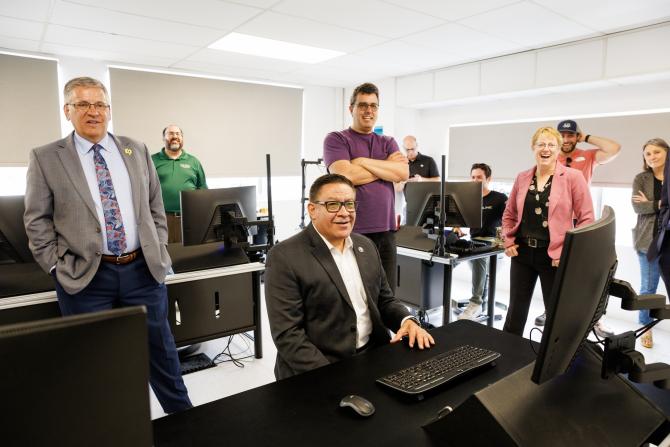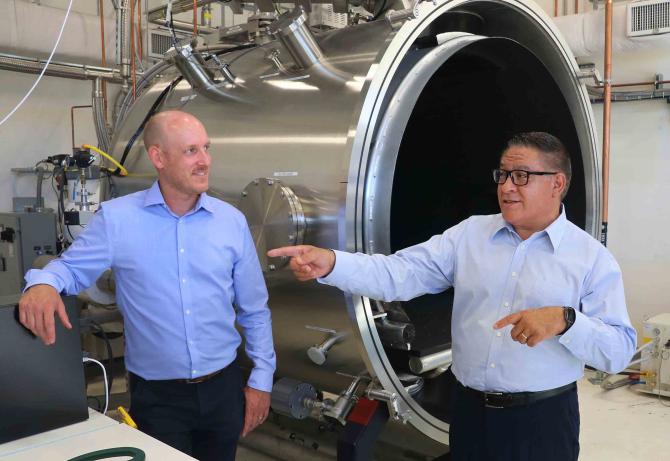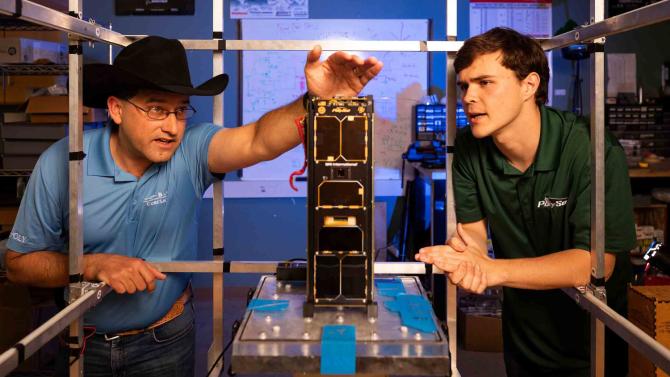Aerospace Engineering
College of Engineering
Aerospace engineers are at the forefront of technological evolution in both air and space – and on the ground. If you hope to be embodied in the forefront of innovation, a degree in aerospace engineering might get you there.
San Luis Obispo, California
The curriculum provides you with a broad understanding of aerospace engineering as well as principles of engineering, physics and mathematics. You will also choose to concentrate on either aeronautics or astronautics.
Laboratories are available for course work and research projects in:
- Aircraft and Spacecraft Design
- Aerothermodynamics
- Computational Fluid Dynamics
- Control Systems
- Finite Element Analysis
- Flight Simulation
- Nano-Satellite Design
- Orbital Debris Analysis
- Propulsion
- Space Environments and Testing Lab
- Structural Test and Analysis
- Subsonic and Supersonic Wind Tunnels
- Thermal Control
- Unmanned Aerial Systems
- Water Tunnel
Aeronautics Concentration
The aeronautics concentration focuses on the design, building and testing of aircraft and related systems and includes courses in low and high speed aerodynamics, flight performance, propulsion systems, aircraft dynamics and control, wind tunnel testing and aircraft design. The concentration will prepare you for work in flight sciences, control, systems engineering, aerodynamics, structures and propulsion. Our students typically move on to careers with the major aircraft producers including Boeing, Lockheed Martin and Northrop Grumman or with the launch vehicle and missile manufactures including Raytheon, Pratt & Whitney and launch integrators such as NASA and ULA.
More about Aeronautics Concentration
Astronautics Concentration
The astronautical concentration focuses on complex space-based systems and will include courses in orbital mechanics, space environment, space environment laboratory, spacecraft propulsion systems, spacecraft attitude dynamics and control, spacecraft power and communications systems and spacecraft design. It will prepare you for work in spacecraft systems engineering and design, orbital analysis, spacecraft structures and propulsion systems, and spacecraft launch integration and testing for major commercial or defense spacecraft producers, including, SSL, Boeing, Northrop Grumman and Lockheed Martin.
Aerospace engineering majors are able to participate in a blended program where you can earn your bachelor's and master's degrees at the same time.
There are two blended programs available to aerospace students and requirements are different for each program:
BS in Aerospace Engineering and MS in Aerospace Engineering
BS in Aerospace Engineering and MS in Mechanical Engineering
About the Program

Aerospace engineering prepares you to create more efficient and economical solutions for aircraft, spacecraft and related systems and equipment such as drones and satellites.
While your studies will include math, physics and engineering concepts, you will also learn how to design, build and test aircraft, spacecraft and other machines that fly or orbit. The program focuses your studies on your own interests and career aspirations by allowing you to choose between an aeronautics or astronautics concentration. The degree program is accredited by the Engineering Accreditation Commission of ABET.
California Impact
From exploring space in the PolySat lab to inventing the future of transportation in our Protoype Vehicles Laboratory, much of your time will be spent engaged in hands-on learning. Industry partnerships throughout California, including nearby Vandenberg Air Force Base, allow you to make connections and utilize real-world technologies. You are able to develop expertise in solving complex problems and the capability to drive innovation in the areas of aeronautics and astronautics.

Science and Technology
Air Force Research Lab
Congressman Celebrates Cutting-Edge Work and Partnership with Air Force Researc…
Science and Technology
Congressman Celebrates Cal Poly
Congressman Celebrates Cal Poly's Partnership with Air Force Research Lab
Space
Space Technology Hall of Fame
Cal Poly’s Game-Changing CubeSats Inducted into the Space Technology Hall of Fa…Our Graduates
Aerospace Engineering graduates are employed in industries whose workers design or build aircraft, missiles, systems for national defense or spacecraft.
Major employers include NASA, Lockheed Martin, Northrop Grumman and United Launch Alliance.
